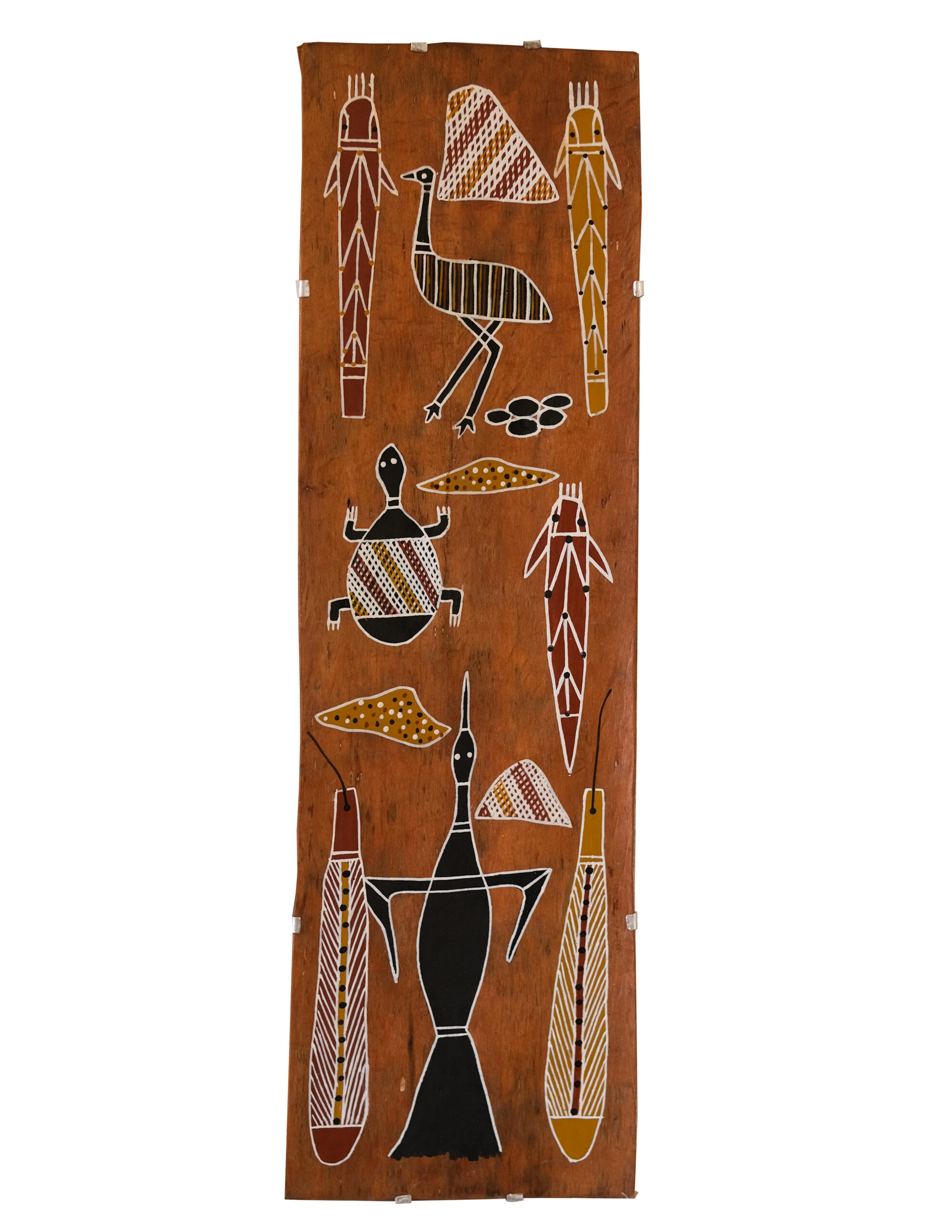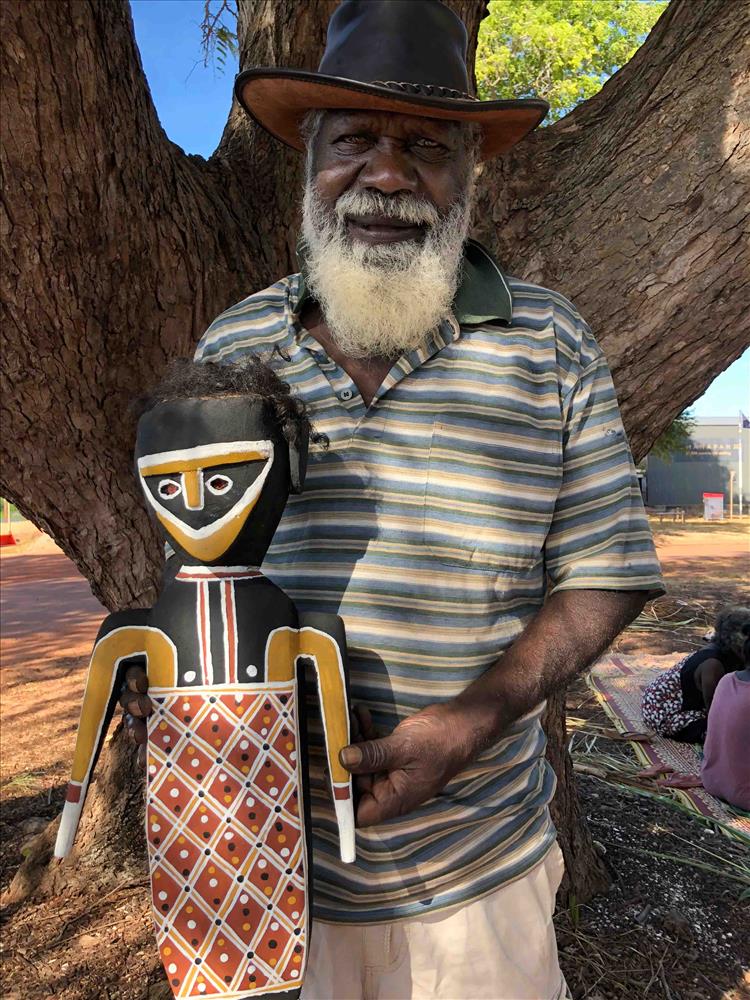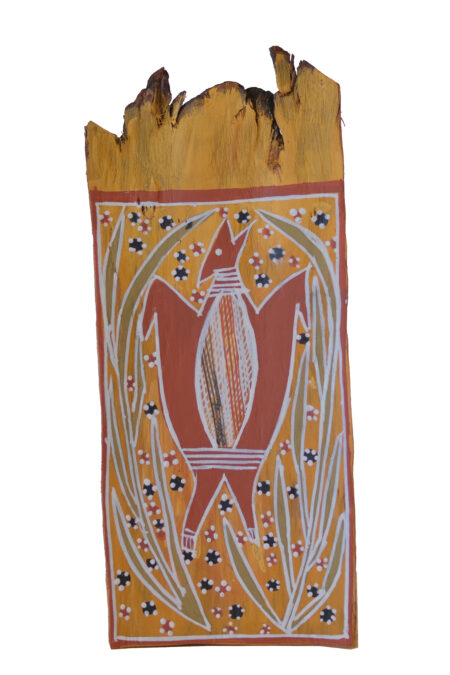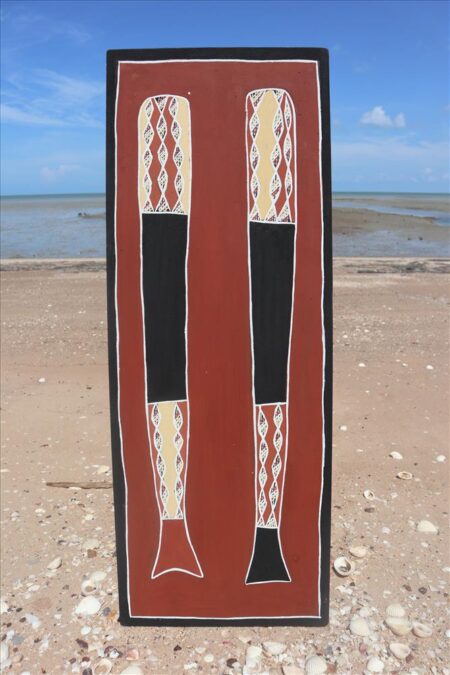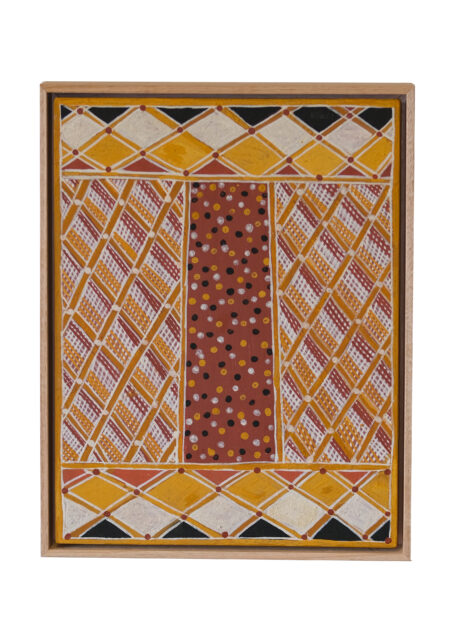Description
This painting depicts the Gupapuyŋu morturary rights ceremony and songline that connects them with many other Yirritja clans across Arnhem Land. In the following story, George Milaypuma explains how Gupapuyŋu people looked after the bones of their ancestors:
Ḻarrakitj ga wiripu yäku ga Djaḻumbu. Dhuwal ŋayi Djaḻumbu ŋunha ŋayi dhiyaŋ bala Gapuwiyakpuy ŋayi Djaḻumbu wo Ḻarrakitj. Ŋunha nhanŋu Ḻarrakitjku wäŋa buraŋur gapuŋur, guḻun gapu ŋunha Gapuwiyak.
Ḻarrakitj, the Gupapuyŋu burial pole is also known as Djaḻumbu. This Djaḻumbu is there now at Gapuwiyak – this Djaḻumbu or Ḻarrakitj. The home of Ḻarrakitj is there in the water, in the middle of the billabong at Gapuwiyak.
Yow dhuwalidhi. Ga ŋunhi ŋayi Ḻarrakitj wo Djaḻumbu ŋayi ŋunha balanya nhakun ŋayi, mokuy dhu dhiŋgam, ga nhanŋu ŋaraka wo Birrinymal ŋayi dhu marrtji bala Ḻarrakitjlil. Dhuwali ŋunhi Ḻarrakitj ŋunhi ga ŋaraka wo Birrinymal gärri ga ŋunha djinaga ḻarraktijŋur. Yow. Dhuwal ŋunhidhi dhäwu Ḻarrakitjpuy wo Djaḻumbuw. Märrma’ ŋayi yäku.
Yes, it’s there. And that Ḻarrakitj or Djaḻumbu there, it’s like this, when someone dies, their bones, or Birrinymal, they will go into the Ḻarrakitj. This is the Ḻarrakitj into which the bones, or Birrinymal will go. Yes. That is the story of Ḻarrakitj, or Djaḻumbu. It has two names.
Nyaŋura ga guya Manburi wo Ginyginy napurr dhu bakmaraman nyumukuṉinyguma munguykuma. Ga napurr dhu yolŋu märrama, yolŋu Birrinymal ga napurr dhu maṉdanha waŋganyguma. Napurr dhu manapana Birrinymalnha ga Guya ga Nyaŋura ga Burala ga Wurrpaṉ. Napurr dhu waŋganyguma walalanha ḏiwirrk-ḏiwirrkmarama ga buŋgulmirr ŋunhi dhu djälthirr napurr nhirrpan Ḻarrakitj ga napurr dhu ŋunhili Birrinymal märrama warrpam’ bala galkana Ḻarrakitjlil djinagalil, bala napurr dhu buŋgulnha djäma.
Long-necked turtle and Catfish [bones] – we break them into small pieces. And we get the bones of the person – the Birrinymal – and we combine the two [the animal and the human bones]. We combine the Birrinymal and fish and Long-necked Turtle and Diving Bird bones. We mix them together and crush them, and when we are ready to have a ceremony and erect a Ḻarrakitj, we get all of the Birrinymal [the mixture of sacred Gupapuyŋu bones] and put them into the Ḻarrakitj, and then we perform the ceremony.
Ga dhiyaŋ bala ŋunha ŋayi Ḻarrakitj ŋunhi ŋayi miny’tji nhanukal ga gorruma, Burala, Nyaŋura, Ginyginy, Manburi ga Wurrpaṉ. Nhanŋu dhuwalinydja miny’tji Ḻarrakitjku ga Djaḻumbuw.
And now, here is the Ḻarrakitj with the designs painted onto it: Diving Bird, Long-necked Turtle, Catfish and Emu. These are the designs that belong to this burial pole.
Ŋunhi dhu ŋayi bakthun Ḻarrakitj ga ŋayi dhu Djuŋgaya märra’marrama Birrinymal ga rulaŋdhun bathilil – ŋunhi dhuyu bathi. Dhuyu ŋayi dhuwali bathi. Baladhi ŋayi dhu rulaŋdhun. Ga galkun ŋayi dhu ga nhätha napurr dhu waŋanhamirri, Ḻarrakitjku: “Ḻimurru Ḻarrakitj nhirrpan”, ga buŋgul djäma.
When the Ḻarrakitj gets old and breaks, the Djuŋgaya (caretaker of the clan business) will get the Birrinymal and store them in a bag – a sacred dillybag. The bag is sacred. They will be stored in there. And he will wait until we discuss [having another] Ḻarrakitj [ceremony]: “Shall we? Let’s erect a Ḻarrakitj”, and perform the ceremony.
Ga napurr dhu ŋunhidhi bili Birrinymal mala bulu ŋunhidhi. Bitjan bili dhu ga. Nhakuna Ḻarrakitj dhu ga dhärra balanya, ga bäy ŋayi dhu bakthun, napurr dhu yuṯakuma Ḻarrakitj ga napurr dhu ŋunhi bili märrama ga galkan Ḻarrakitjlil Birrinymaldja mala. Baladhi bili Ḻarrakitjlil. Bala napurr dhu buŋgulnha djäma. Ga bitjan bili napurr dhu nhäma yan wo dhärray dhu ga.
And we will put the Birrinymal into a Ḻarrakitj again. It continues. As in a Ḻarrakitj will be standing there, and when it breaks down, we renew it. We get the Birrinymal and put them into a Ḻarrakitj again. Always into the Ḻarrakitj. Then we do a ceremony. And then we keep an eye on it – it just stays there.
Ga yalalaŋumirri dhuŋgarra dhuŋgarra dhuŋgarra, three waltjaṉ wo four waltjaṉ, napurr dhu bulu yuṯakuma. Ga dhuwalana ŋunhi dhäwunydja Ḻarrakitjpuydja. Dhiyalnha ga dhäwu dhawar’yun nhanŋu.
And later, years on, maybe after three or four wet-seasons, we renew it again. And that is the story of Ḻarrakitj. This is where the Ḻarrakitj story ends.
Notes:
At the start of this story the artist alludes to another story, which connects Ḻarrakitj to its country in the water at Gapuwiyak. He might tell that story another time. But he explains that if someone asks to take that Ḻarrakitj to the billabong, they tell them that it is already there. The ancestors already went there and the Ḻarrakitj is already in the water. Now, he explains, when Gupapuyŋu people erect a Ḻarrakitj in a dry area, they represent that Ḻarrakitj which is in the water.
Birrinymal is a name used to refer to the bones of a Gupapuyŋu person who has passed away. This term also refers to the bones of Gupapuyŋu totems including Burala (Diving Bird), Nyaŋura (Long-necked Turtle), Ginyginy (Catfish) and Wurrpaṉ (Emu). It is a word used to speak respectfully and sensitively of the Gupapuyŋu dead, rather than speaking their names. By using this word the speaker connects the dead person to their place in the cosmos.
Milaypuma explains that these days, people are buried in the ground and they are left there. They don’t exhume them like in the past. But he explains that Gupapuyŋu people continue the tradition by collecting the bones of Wurrpaṉ, Nyaŋura, Burala and Ginyginy. They keep the bones, and later crush them and mix them with the Birrinymal that they have kept in their sacred dillybag. And maybe there is a small piece of their ancestors in that bag.
Story and explanations by George Milaypuma, transcription and translation by Salome Harris, October 2022
